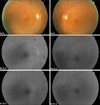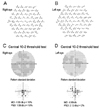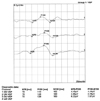Abstract
A 63-year-old man with a history of liver transplantation presented to our clinic complaining of visual disturbance. He had been receiving tacrolimus (FK 506) for 30 months (6 mg/day for 2 years and 3 mg/day for 6 months); he reported that the visual disturbance began while taking tacrolimus. A full ophthalmologic examination and electrophysiologic and imaging studies were performed. The best corrected visual acuity was 0.1 in both eyes. There were no abnormal finding in the anterior segment, pupillary reflexes were normal and, there was no swelling in either optic disc. Although the foveal reflex was slightly decreased, fluorescein angiography revealed non-specific signs, with the exception of a window defect. A multifocal electro-retinogram revealed decreased amplitude of the central ring. A Swedish interactive threshold algorithm-standard 10-2 visual field test revealed a central scotoma. These findings suggest that tacrolimus may result in maculopathy. Therefore, careful ophthalmologic examination is necessary in the patients taking tacrolimus.
Tacrolimus (FK 506; Prograf, Fujisawa USA Inc., Deerfield, IL, USA), a fungal metabolite produced by Streptomyces tsukubaenis, is an effective immunosuppressive agent used in bone marrow and organ transplantation patients. Tacrolimus inhibits cytokine synthesis and blocks T-cell development. Cortical blindness associated with bilateral occipital white matter lesions and bilateral optic neuropathy was reported in one patient on tacrolimus [1-3]. However, there have been no reports of maculopathy associated with the use of this agent. We report a patient who developed maculopathy in both eyes as a possible complication of tacrolimus therapy.
In August 2008, a 63-year-old man presented with gradual onset blurry vision in both eyes. He had initially developed the visual disturbance one year prior at that time, his best corrected visual acuity was 20/30 in both eyes. On slit lamp examination, the anterior and posterior segments of both eyes showed no significant findings and further ophthalmologic exam was not performed. He had a history of liver transplantation for chronic hepatitis B-related cirrhosis, 2 years prior to presentation. He denied any other significant medical history, including hypertension, diabetes mellitus, and trauma. He also had no significant family history and no clinical or laboratory signs of a graft versus host reaction. He had been taking tacrolimus (Prograf) for 30 months (6 mg for 2 years and 3 mg for 6 months) and had noted the gradual onset of the visual disturbance in conjunction with the immunosuppressive therapy. He had also been taking multiple other drugs, including digestives, antihistamines, expectorants, and Cellcept (Syntex Puerto Rico Inc., Humacao, Puerto Rico).
His best corrected visual acuity was 20/200 in both eyes. Both pupils were reactive to light, and no relative afferent pupillary defect was noted. The intraocular pressure was 9 mmHg in the right eye and 10 mmHg in the left eye. Both lenses were mildly opacified on slit lamp examination. The Ishihara color test showed total dyschromatopsia in both eyes. No swelling or pallor was noted in either optic disc. Although the foveal reflex was slightly decreased, no bulls eye phenomenon was noted. Fluorescein angiography revealed non-specific signs, with only a window defect caused by retinal pigment epithelium (RPE) atrophy (Fig. 1). Optical coherence tomography also revealed non-specific finding in the fovea (Fig. 2). Electroretinography (ERG) demonstrated a delayed a wave and b wave latency during the photopic response; the response amplitude was slightly decreased in the left eye. Multifocal ERG showed decreased amplitude in the central ring one in both eyes (Fig. 3A and 3B). The Humphrey perimeter (Humphrey Instruments Inc., San Leandro, CA, USA) static visual field with central 10-2 threshold test revealed a central scotoma (Fig. 3C and 3D). Visual evoked potential (VEP) testing demonstrated a P100 delay in both eyes (Fig. 4). A coagulation factor deficiency was not found and the platelet count was within the normal range on serologic testing. Computed tomography revealed no abnormalities. At the final visit, the patient's best corrected visual acuity was maintained at 20/200 in both eyes, some RPE changes were observed on fundus examination.
In patients taking tacrolimus, several factors may lead to visual disturbance. First, such patients may develop optic neuropathy. Brazis et al. [1] reported that bilateral optic neuropathy may stem from the direct neurotoxic effects of tacrolimus. Although VEP testing demonstrated a mild P100 delay, the present patient did not exhibit disc swelling or disc pallor. A mild, focal, central scotoma was noted on visual field testing and foveal suppression was observed on multifocal ERG. Therefore, maculopathy was considered a more likely source of the visual disturbance than optic neuropathy.
Cortical blindness is another possible cause of symptoms in patients such as the one described in this report. Magnetic resonance imaging easily demonstrates the white matter lesions attendant to tacrolimus and cyclosporine toxicity [2]. Although magnetic resonance imaging was not performed in this patient because of claustrophobia, brain computed tomography revealed no abnormalities. Therefore, this patient's visual disturbance was unlikely to have been associated with cortical blindness.
We have no definitive explanation for the mechanism behind the maculopathy in this patient. Tacrolimus may have a direct neurotoxic effect on the RPE, cone cells, or rod cells. Furthermore, vasoconstriction may be induced along with the maculopathy, resulting in neural tissue damage and tissue ischemia [2]. Furthermore, another possible mechanism for the development of maculopathy could involve focal proliferation and loss of the RPE, predominantly in the fovea, similar to that seen with cyclophosphamide and cytarabine in a patient with central nervous system lymphoma [4]. In conclusion, we suggest that tacrolimus may cause retinal maculopathy. Therefore, careful ophthalmologic examination is necessary in patients taking tacrolimus.
Figures and Tables
References
1. Brazis PW, Spivey JR, Bolling JP, Steers JL. A case of bilateral optic neuropathy in a patient on tacrolimus (FK506) therapy after liver transplantation. Am J Ophthalmol. 2000. 129:536–538.
2. Steg RE, Kessinger A, Wszolek ZK. Cortical blindness and seizures in a patient receiving FK506 after bone marrow transplantation. Bone Marrow Transplant. 1999. 23:959–962.
3. Kessler L, Lucescu C, Pinget M, et al. Tacrolimus-associated optic neuropathy after pancreatic islet transplantation using a sirolimus/tacrolimus immunosuppressive regimen. Transplantation. 2006. 81:636–637.
4. Galor A, Ference SJ, Singh AD, et al. Maculopathy as a complication of blood-brain barrier disruption in patients with central nervous system lymphoma. Am J Ophthalmol. 2007. 144:45–49.




 PDF
PDF ePub
ePub Citation
Citation Print
Print






 XML Download
XML Download